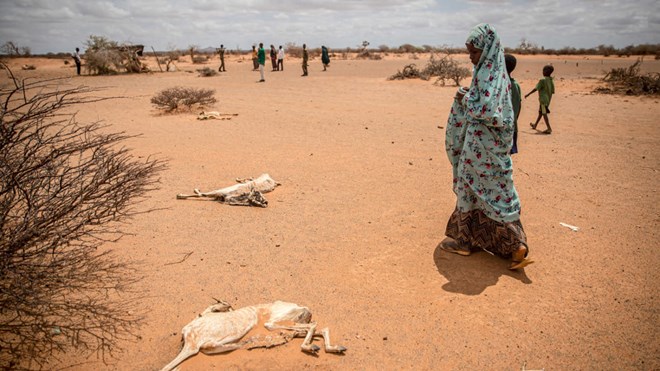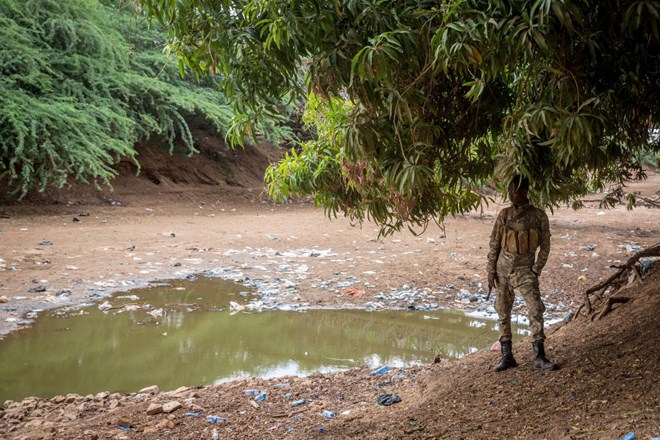
Friday August 19, 2022

A child displaced by drought walks past the rotting carcasses of goats that died from hunger and thirst, on the outskirts of Dollow, Somalia. (Sally Hayden/SOPA Images/LightRocket via Getty Images)
The World Health Organization warned on Wednesday that millions of people in East Africa face the threat of starvation. Speaking at a media briefing in Geneva, WHO Director-General Tedros Adhanom Ghebreyesus said that drought, climate change, rising prices and an ongoing civil war in northern Ethiopia are all contributing to worsening food insecurity.
Over 50 million people in East Africa will face acute food insecurity this year, a study from late July by the World Food Programme and Food and Agriculture Organization found. Roughly 7 million children are suffering from malnourishment and, according to the United Nations High Commissioner for Refugees, hundreds of thousands are leaving their homes in search of food or livelihoods. Affected countries include Djibouti, Ethiopia, Kenya, Somalia, South Sudan, Sudan and Uganda.
“The current food security situation across the Horn of Africa is dire after four consecutive rainy seasons have failed, a climatic event not seen in at least 40 years, or since the beginning of the satellite era,” Chimimba David Phiri of the Food and Agriculture Organization said in the report.
The warnings have been gradually building for months, as the situation worsens. In June, David Nash, a physical geographer at the University of Brighton, reported for the Conversation that “large areas of Ethiopia, Somalia and Kenya are currently in the grip of a severe drought.”
The Horn of Africa has two rainy seasons per year, but the last four have been unusually dry. In some regions of Somalia, it has not rained in two years, according to Reuters.
“This meteorological drought has resulted in a loss of soil moisture, caused waterways to dry up, and led to the death of millions of livestock,” Brighton reported. “Forecasts suggest that the September to December rainy season could also fail. This would set the stage for an unprecedented five-season drought.”
Climate change increases the risk of drought because warmer air causes more evaporation and throws off the natural water cycle.
“Climate change and La Niña have caused an unprecedented multi-season drought [in East Africa], punctuated by one of the worst March-to-May rainy seasons in 70 years,” the U.N. News Service reported last month.
The drought has had a devastating effect on crop yields and on livestock populations. In Somalia, vegetable and grain production is expected to drop by about 80% this year.
Russia’s invasion of Ukraine, which has stalled grain exports for both countries, has also had a cascading effect for countries that relied on the crop. According to the Foreign Policy Research Institute, a U.S-based think tank, “Somalia is entirely dependent on Ukraine (70 percent) and Russia (30 percent) for wheat imports.

A soldier stands in front of the dried up Jubba River near the Ethiopian border. (Sally Hayden/Sopa Images/LightRocket via Getty Images)
Although Ukraine and Russia signed an agreement to ensure grain exports are would resume from ports on the Black Sea, Russia subsequently bombed a port in the Ukrainian port city of Odesa and has placed mines on trade routes.
The Russia-Ukraine war also comes on top of ongoing violent conflicts in East Africa that can impede food production and distribution.
The Islamist terrorist group al-Shabab controls over 20% of Somalia. Attacks by al-Shabab have increased since the Trump administration withdrew U.S. troops from the country in December 2020. The Biden administration redeployed 500 soldiers to Somalia earlier this year.
And in the Tigray region of Ethiopia, the government military, ethnic militias and soldiers from Eritrea are fighting the Tigray People’s Liberation Front, a political party that the Ethiopian government considers a terrorist organization.
Droughts and the resulting famines can themselves also create political instability and violent conflict. Various uprisings, including the 2011 Arab Spring protests in Tunisia and the civil war in Syria, have been linked in part to drought and climate-change-related food shortages.
In July, the U.S. Agency for International Development committed to spending $1.2 billion on food aid for Somalia, Ethiopia and Kenya. The U.N., however, says that more funds are needed. And experts argue that the international community must help countries in the region access longer-term solutions to mitigate the risks of climate change such as drought-resistant technologies and water preservation strategies.